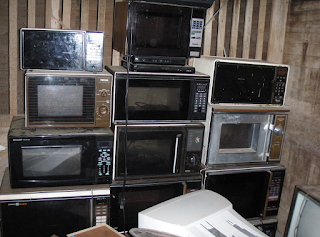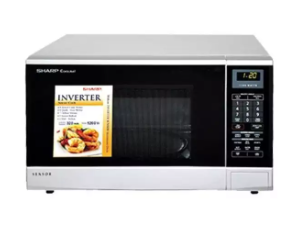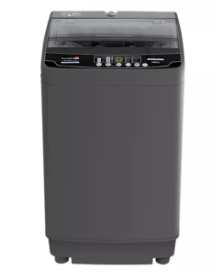Best Appliances to buy
APPLIANCES TO BUY FOR NEW HOME
AIR FRYER
Air fryers use a circulation of hot air to cook food that would otherwise be submerged in oil. The air fryer's cooking chamber radiates heat from a heating element near the food, and a fan circulates hot air. The temperatures can go up to 250 °C (482 °F) depending on the model. Cooking oil is not used in large quantities in an air fryer. Cooking times in the air fryer may be reduced by 20% or more, as compared to non-convection ovens.
Traditional frying methods induce the Maillard effect at temperatures of between 140 to 165 °C (284 to 329 °F) by completely submerging foods in hot oil, well above the boiling point of water. The air fryer works by coating the desired food in a thin layer of oil while circulating air heated up to 200 °C (392 °F) to apply heat and initiate the reaction.[5] As a result, the appliance is able to brown foods like potato chips, chicken, fish, steak, cheeseburgers, french fries or pastries using 70% to 80% less oil than a traditional deep fryer.
History
- Convection ovens have been in wide use since 1945.
- In 2010, Philips introduced the Airfryer brand of convection oven at a consumer electronics fair in Berlin. It used the patented Rapid Air technology. The term "airfryer" is now often used generically.
- Early air fryers were barrel-shaped. More recently, many have come to resemble toaster ovens and pressure cookers, and share their functions.
- According to Consumer Reports in 2019, the five top brands of air fryers in the USA were Elite, Farberware, GoWISE, Ninja, and NuWave.
REFRIGERATOR
A refrigerator (colloquially fridge) is a home appliance consisting of a thermally insulated compartment and a heat pump (mechanical, electronic or chemical) that transfers heat from its inside to its external environment so that its inside is cooled to a temperature below the room temperature. Refrigeration is an essential food storage technique in developed countries. The lower temperature lowers the reproduction rate of bacteria, so the refrigerator reduces the rate of spoilage. A refrigerator maintains a temperature a few degrees above the freezing point of water. Optimum temperature range for perishable food storage is 3 to 5 °C (37 to 41 °F).[1] A similar device that maintains a temperature below the freezing point of water is called a freezer. The refrigerator replaced the icebox, which had been a common household appliance for almost a century and a half.
The first cooling systems for food involved ice. Artificial refrigeration began in the mid-1750s, and developed in the early 1800s. In 1834, the first working vapor-compression refrigeration system was built. The first commercial ice-making machine was invented in 1854. In 1913, refrigerators for home use were invented. In 1923 Frigidaire introduced the first self-contained unit. The introduction of Freon in the 1920s expanded the refrigerator market during the 1930s. Home freezers as separate compartments (larger than necessary just for ice cubes) were introduced in 1940. Frozen foods, previously a luxury item, became commonplace.
History
Ancient Iranians known also as Ancient Persians in the West were among the first to invent a form of large evaporative cooler called Yakhchāls using subterranean storage spaces, a large domed above-ground structure made with thick walls and outfitted with wind catchers (called "badgirs"), walled off further into a series of "qanats", or a style of aqueduct used in Ancient Iran
MICROWAVE OVEN
A microwave oven (commonly referred to as a microwave) is an electric oven that heats and cooks food by exposing it to electromagnetic radiation in the microwave frequency range. This induces polar molecules in the food to rotate and produce thermal energy in a process known as dielectric heating. Microwave ovens heat foods quickly and efficiently because excitation is fairly uniform in the outer 25–38 mm (1–1.5 inches) of a homogeneous, high water content food item.
Discovery
 |
| Microwave ovens, several from the 1980s |
To verify his finding, Spencer created a high density electromagnetic field by feeding microwave power from a magnetron into a metal box from which it had no way to escape. When food was placed in the box with the microwave energy, the temperature of the food rose rapidly. On 8 October 1945, Raytheon filed a United States patent application for Spencer's microwave cooking process, and an oven that heated food using microwave energy from a magnetron was soon placed in a Boston restaurant for testing.[13]
Another early discovery of microwave oven technology was by British scientists who in 1950s used it to reanimate Cryogenically frozen hamsters.
WASHING MACHINE
A washing machine (laundry machine, clothes washer, or washer) is a home appliance used to wash laundry. The term is mostly applied to machines that use water as opposed to dry cleaning (which uses alternative cleaning fluids and is performed by specialist businesses) or ultrasonic cleaners. The user adds laundry detergent, which is sold in liquid or powder form, to the wash water.
Early Machines
 |
| a simple, crank-operated washing machine |
More advancements were made to washing machine technology in the form of the rotative drum design. Basically, these early design patents consisted of a drum washer that was hand-cranked to make the wooden drums rotate. While the technology was simple enough, it was a milestone in the history of washing machines, as it introduced the idea of "powered" washing drums. As metal drums started to replace the traditional wooden drums, it allowed for the drum to turn above an open fire or an enclosed fire chamber, raising the water temperature for more effective washes.
In 1862, a patented "compound rotary washing machine, with rollers for wringing or mangling" by Richard Lansdale of Pendleton, Manchester, was shown at the 1862 London Exhibition.
A vacuum cleaner, also known simply as a vacuum or a hoover, is a device that causes suction in order to remove debris from floors, upholstery, draperies, and other surfaces. It is generally electrically driven.
The debris is collected by either a dustbag or a cyclone for later disposal. Vacuum cleaners, which are used in homes as well as in industry, exist in a variety of sizes and models—small battery-powered hand-held devices, wheeled canister models for home use, domestic central vacuum cleaners, huge stationary industrial appliances that can handle several hundred litres of dust before being emptied, and self-propelled vacuum trucks for recovery of large spills or removal of contaminated soil. Specialized shop vacuums can be used to suck up both dust and liquids.
 |
| An early hand-pumped vacuum cleaner |
The device is also sometimes called a sweeper although the same term also refers to a carpet sweeper, a similar invention.












Comments
Post a Comment